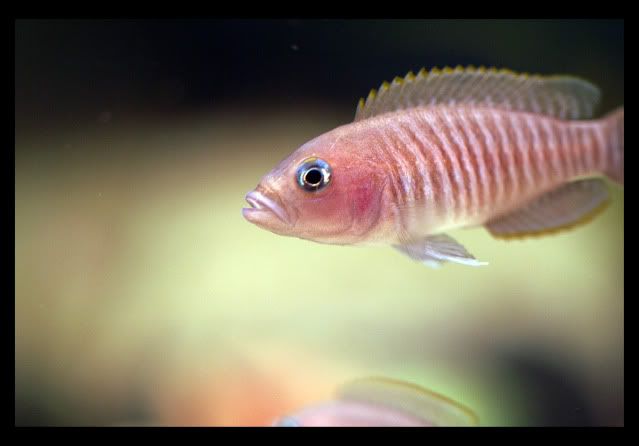Post by pezerologo on May 1, 2015 1:51:37 GMT
Hi everyone !!!
Today we know a very interesting and beautiful of the Venezuelan eastern plains ecosystem.
Venezuela with Brazil and Peru are the richest ichthyofauna from around South America and can be found in almost any body of water.
The present case are called Morichales in Venezuela
Morichales are wetlands dominated wooded marsh where the species Mauritia flexuosa or moriche Palm.
These plant formations are located in the states of Monagas, Anzoategui, Delta Amacuro, Guarico and Apure.
To a lesser extent also found in the states of Amazonas and Bolivar, as we can see their distribution is wide.
In Brazil they are known as Buriti, in Colombia Canangucho in Bolivia Caranday in Peru Aguaje and Ecuador Morete .

Among the different types of Morichales, the closed type is one that keeps water throughout the year to a greater or lesser extent.
They are characterized by a high density of adult moriche Palm, as well as scattered juveniles.
This interesting ecosystem supports a rich variety of fish fauna both in mainstream and in small streams leading into the Morichal.

The Uracoa River is fairly unknown, yet little visited, which is why its waters are an attractive and diverse community of fish, reaching today at 34 plant species and 22 species reaching these.
By the physical characteristics of the land, the water flows slowly, with an ambient temperature of 27 ° C and an annual rainfall of 1000mm.
These waterways have very clear waters because Mauritia flexuosa digs its roots in the ground to reach underground water deposits. This causes water outcrops starting to saturate the liquid element large floor areas. While generating small ponds and streams that flow into larger courses.
In these environments the soil is covered with plant debris decaying underwater also find this feature, where countless leaves, branches, stems, fruits or seeds are submerged causing acidification of the aquatic environment. During the rainy season overflows with fish also agree to reserve all this food, places for spawning and shelter.
We can distinguish habitats into several groups:
Main Canal: It contains most of the water from this system has a high and constant speed and relatively clear channels.
Submerged meadows: Different plant species create dense masses or as isolated specimens submerged when in the current of the main channels. could highlight the species Eichornia diversifolia.
Floating meadows: abound in the margins of the main channel and may occupy an area covering several meters. The Eichhornia crassipes and Paspalum repens among others, form a compact mass attached to roots, leaves and branches of riparian vegetation, creates microhabitats suitable for small species.
Backwaters Marginal: On the sides of the channels and also from other rivers, these places there is a lenitica current, and even reversed to the original channel are generated. Usually they created by an obstacle in the main channel such as a sandbar, detachment from the shore or other natural causes.
At these points proliferate floating plants like Nymphaea, Salvinia and Pistia. Submerged plants also take advantage of these favorable circumstances to thrive in large number.
Flooded Forest: less frequent since it only occurs during the rainy season. Depending on the terrain this can be extended from a few meters to a hundred, on both sides of the main channel.
Being located on a forest with a canopy impenetrable to the relentless sunlight, shade conditions prevail preventing the explosive growth of aquatic vegetation. However the different species of fish enjoy this area to find food, places to conduct spawning or colonize new territories.
The floor in this room is composed of sheets or palm Mauritia flexuosa moriche palm, trunks, branches, sticks and roots in large numbers.

Biotope finally chosen is the Marginal Backwaters in an environment that is found feasible to simulate in a domestic aquarium.
Given the great diversity of species we can choose various types of aquariums in relation to our budget, available space or knowledge.
For a single species the aquarium should not be less than 50-60 liters. In case you want to mount a small community, depending on the target species and the number of them, would be an acceptable size in 120-150 liters. If possible, we choose a lower and wider than the standard size aquarium, so the area is available to increase fish living near the bottom, to delimit their territories.
A larger size, from 400 liters allow us to maintain a more diverse community and provide space for more vivid species as well as the possibility of keeping a larger size fish.
The filtration must be efficient in relation to the amount of fish and plants, we recommend using resin to acidify the water, so the selected species will have a better appearance and health.
As for the lighting, it should be sufficient for the needs of the plants that populate our aquarium.
Floating weeds typically have a high light requirement.
The type of lighting is in charge of the preferiencias aquarist here. As always we recommend LED display for low power consumption and high efficiency cogeneration.
The parameters of the water, telling that while the selected species come from a biotope where water can be very acidic (ph4.5), these are mostly bred in fish farms where the water is much more neutral. We do not stop to offer similar to its place of origin. To achieve a balance between supply of acid water for water changes and the needs of fish, a pH around 6.0 will be enough to see the best colors and reproductive behavior as well as good health and disease resistance.
The optimal temperature range is between 25 ° C and 27 ° C, may be higher but this circumstance, speeds up the metabolism of the fish and reduces their life expectancy.
A good weekly water change with a preconditioned water is essential to maintain this balanced biotope for a long period of time.
For the decoration will pay attention to detail to ensure simulate in the best way possible this biotope Marginal Backwaters.
The ground will be composed of clear sand of a grain size not too thin to allow good development of the roots of submerged plants. We can also choose to place the substrate at first and then cover with a generous layer of sand. Trunks, branches, leaves, small rocks or pebbles, simulate the original habitat and allow Apistogramma cichlids like to define their territories and take a walk to their fry when the time comes.
Let the free front and center of plants or failing there plant the small. Throughout the rear we will put enough fast-growing plants, or in his absence by offering copies of lading shelter places more timid species. Among them we can put some sticks or branches that simulate be the roots of riparian vegetation. They will also offer a place to put the floating plants and their roots help to recreate this interesting aquatic environment.
It is important to introduce a lot of Terminalia leaves, Quercus or Fagus. Unable to get branches and leaves of Mauritania flexuosa in these latitudes and coloring slightly water, the above-mentioned remain the best option.
And with the question of decoration resolved for good simulation we will see the fish species to be found in this habitat Marginal Backwaters.
As it is predictable characids abound, with some small cichlids and catfish lesser extent.
The ratio of species is as follows:
TETRAS
-Bryconops melanurus
-Hemigrammus sp.
-Hyphessobrycon sp.1
-Hyphessobrycon sp.2
-Moenkhausia sp.
-Moenkhausia collettii
-Pristella maxilaris
-Characidium sp.
-Copella sp.
-Poecilobrycon eques
CICHLIDS
-Aequidens sp.
-Apistogramma sp.
-Crenicichla saxatilis
-Cichlasoma festivum
-Geophagus jurupari
CATFISH
-Burnocephalus sp.
-Farlowella sp.
-Microglanis poecilius
This variety is clearly not going to be able to introduce all so we must choose among them more pleasing to us, are accessible for not being extracted from nature.
therefore I have decided to replace species that necessarily should be captured at their place of origin, species that live nearby but this other nearby river and be widely distributed by breeders and fans.
Let's see what would these selected species.

Moenkhausia collettii reaches a maximum size of 5 cm and has a peaceful and gregarious behavior. Although he likes to swim in open areas it is not uncommon to find near areas with extensive vegetation. Its reproduction is possible and desirable to end the extraction of ornamental species exes in their hometowns.
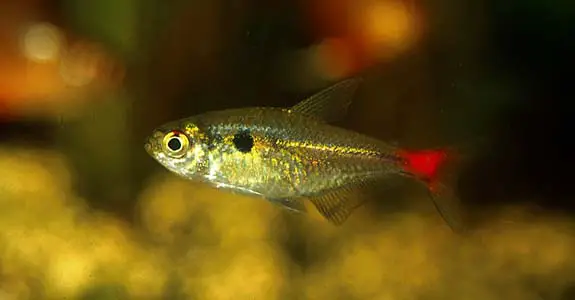
Hemigrammus stictus with its striking red spot on the caudal fin, called attention if we keep a group of them.
While it is not the exact species that inhabit this river, if it is very close in terms of coloration to Hemigrammus sp. and being a widespread species in breeders, wholesalers and enthusiasts, it seems the most sostenble option.
With a size of 4 cm and a gregarious and peaceful behavior, we can introduce a large shoal of them.

A group of Pristella maxilaris always attracts attention with its attractive semi-transparent colored body and fins. Its size is 4.5 cm in maximum and is a predator of small prey that traps in the water and on the surface, even peck on everything that falls into the water.
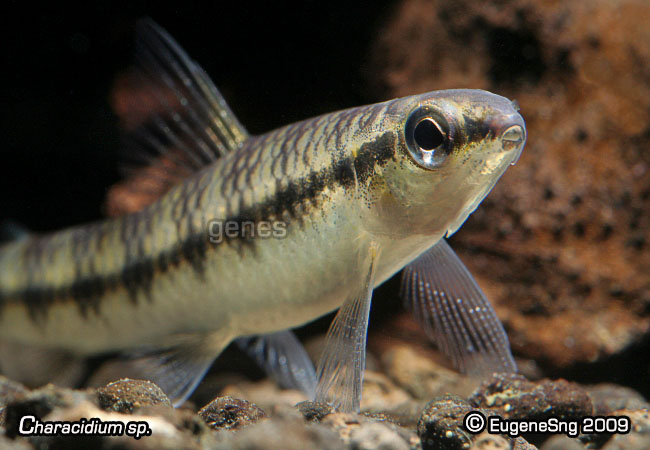
The Gender Characidium is very interesting, unfortunately its reproduction is not simple and are not common in the trade. They reach a size smaller than 10 cm and swimming behavior and remind gobies. If we get this sort, we provide hiding places and crannies in which to take refuge.

The Copella are attractive fish, with a different behavior to other characins presented so far.
He prefers the highlands, taking refuge between floating or marginal vegetation where you get food in the form of insects and other small invertebrates.
Some species have an original system for spawning.
They do leaves above the water surface, jumping coordinated male and female, leaving the eggs that will keep wet, salpicandolos with your body movements and an amazing marksmanship.
They reach a size less than 6 cm most species and can choose between the more accessible or more coloration that do not like.

This small pencilfish Poecilobrycon eques, with its beautiful coloring and peculiar behavior staying suspended a few centimeters below the surface, draw attention and create contrast to the other characins selected.
Reaches a maximum size of 3.5 cm and likes acidic waters, introduce an abundance of these fish it is important for proper maintenance, so we usually give it live food, according to the small size of its mouth

Cichlid species Aequidens abound in northern South America. They are mostly peaceful fish, only during playback defend a territory that are expanding to feed their fry. If I had to opt for one would be the Aequidens maronii or lock Cichlid, while not live in this particular river if he does in the near Orinoco Delta.
Easy to peaceful behavior and reproduction, it is highly recommended for this installation species.
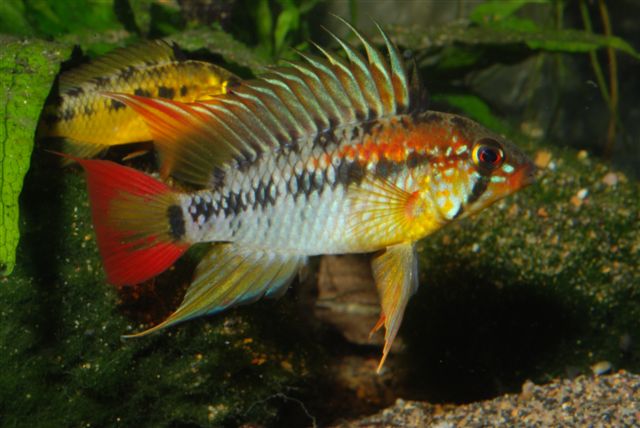
A typical fish of Morichales are Apistogramma. In this case I selected the species Apistogramma macmasteri since come mostly from breeders (the aquaristic market eventually appear wild) and has a wide distribution in the Venezuelan plains. Its color is very beautiful with bright colors and will become the star of the aquarium. Reaches a size less than 6 cm male, remaining female approximately 4.5 cm. Its reproduction is possible even get a large number of fry forward involves dedication.
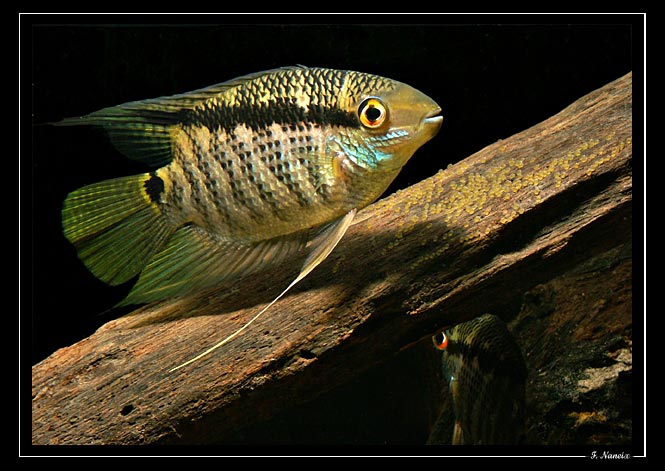
The Mesonauta festivum but with a maximum size of 10 cm, this small cichlid look like a giant in our aquarium.
It has a shy behavior and likes to inhabit more areas planted water bodies it inhabits. There is shelter and a place to be quiet.
Customary in the trade, they are not popular because of off color they have in exhibition aquariums.

The Microglanis poecilius is a small catfish that reaches a maximum height of 6.5 centimeters.
They have a peaceful and calm demeanor, which together with its attractive coloration should make it a recommended inhabitant, for community aquariums Amazonian or South American.
When in shops most people dare not buy Sheatfish for what might happen. With this kind we not err us as the evening comes, prowling around the aquarium foraging.
Among the plant species found some well known and others less, the list of viable species kept in the aquarium is the following.
-Elocharis acicularis
-Ceratophyllum demersum
-Eichornia diversifolia
-Eichornia crassipes
-Salvinia auriculata
-Pistia stratoites
-Ludwigia sp.
Anyway this list has big gaps, information on species of plants in the river basin Uracoa, or not very accessible or appears to be very investigated that aspect.
A look at similar channels within the same area shows us that we found would not be extraordinary specimens of species Sagittaria planitiana or Sagittaria latifolia, and Echinodorus tenellus Echinodorus grandiflorus, Alternanthera sessilis, Rorippa aquatica beautiful, aquatica Cabomba, Tonina fluvialitis, the Lemma minor cosmopolitan, Limnobium laevigatum, Nymphoides indica, the exotic aquatic Ceratopteris pteridoides or Bacopa.
These are some common in shops around the world.
And with that we finished the article on the morichales and more specifically those located on the banks of the Uracoa river. Do not forget that Mauritia flexuosa is an aquatic plant that will always be near these courses and underground water springs and depends on them completely. Likewise fish species in this ecosystem depend on a steady supply of high quality water.
It is important to protect, preserve and study these wild places even to not occur as elsewhere and disappear after a few years of intensive or agricultural use, disappearing with them beautiful scenery underwater and above it.
For now we enjoy this landscape of Venezuela if we dare to mount a Biotope Aquarium in Backwaters Marginal in Morichal of Uracoa River.
I hope you liked the article and have enjoyed your reading, to encourage you to answer or ask culaquier question. If you have fallen by here by chance, be encouraged to register for the forum where every day we try to learn something new.
Gr3tings !!!
Sources
www.fishbase.org
www.wikipedia.org
www.fundacionlasalle.org.ve
www.mikolji.com/
-La vegetacion acuatica del Delta del Orinoco... Giuseppe Colonnello
-Uso del Habitat por la Comunidad de Peces de un Rio Tropical asociado a un Bosque . Luis E. Perez
-La Vegetacion de los Humedales de Agua Dulce de Venezuela . Crispulo Marrero
Today we know a very interesting and beautiful of the Venezuelan eastern plains ecosystem.
Venezuela with Brazil and Peru are the richest ichthyofauna from around South America and can be found in almost any body of water.
The present case are called Morichales in Venezuela
Morichales are wetlands dominated wooded marsh where the species Mauritia flexuosa or moriche Palm.
These plant formations are located in the states of Monagas, Anzoategui, Delta Amacuro, Guarico and Apure.
To a lesser extent also found in the states of Amazonas and Bolivar, as we can see their distribution is wide.
In Brazil they are known as Buriti, in Colombia Canangucho in Bolivia Caranday in Peru Aguaje and Ecuador Morete .

Among the different types of Morichales, the closed type is one that keeps water throughout the year to a greater or lesser extent.
They are characterized by a high density of adult moriche Palm, as well as scattered juveniles.
This interesting ecosystem supports a rich variety of fish fauna both in mainstream and in small streams leading into the Morichal.

The Uracoa River is fairly unknown, yet little visited, which is why its waters are an attractive and diverse community of fish, reaching today at 34 plant species and 22 species reaching these.
By the physical characteristics of the land, the water flows slowly, with an ambient temperature of 27 ° C and an annual rainfall of 1000mm.
These waterways have very clear waters because Mauritia flexuosa digs its roots in the ground to reach underground water deposits. This causes water outcrops starting to saturate the liquid element large floor areas. While generating small ponds and streams that flow into larger courses.
In these environments the soil is covered with plant debris decaying underwater also find this feature, where countless leaves, branches, stems, fruits or seeds are submerged causing acidification of the aquatic environment. During the rainy season overflows with fish also agree to reserve all this food, places for spawning and shelter.
We can distinguish habitats into several groups:
Main Canal: It contains most of the water from this system has a high and constant speed and relatively clear channels.
Submerged meadows: Different plant species create dense masses or as isolated specimens submerged when in the current of the main channels. could highlight the species Eichornia diversifolia.
Floating meadows: abound in the margins of the main channel and may occupy an area covering several meters. The Eichhornia crassipes and Paspalum repens among others, form a compact mass attached to roots, leaves and branches of riparian vegetation, creates microhabitats suitable for small species.
Backwaters Marginal: On the sides of the channels and also from other rivers, these places there is a lenitica current, and even reversed to the original channel are generated. Usually they created by an obstacle in the main channel such as a sandbar, detachment from the shore or other natural causes.
At these points proliferate floating plants like Nymphaea, Salvinia and Pistia. Submerged plants also take advantage of these favorable circumstances to thrive in large number.
Flooded Forest: less frequent since it only occurs during the rainy season. Depending on the terrain this can be extended from a few meters to a hundred, on both sides of the main channel.
Being located on a forest with a canopy impenetrable to the relentless sunlight, shade conditions prevail preventing the explosive growth of aquatic vegetation. However the different species of fish enjoy this area to find food, places to conduct spawning or colonize new territories.
The floor in this room is composed of sheets or palm Mauritia flexuosa moriche palm, trunks, branches, sticks and roots in large numbers.

Biotope finally chosen is the Marginal Backwaters in an environment that is found feasible to simulate in a domestic aquarium.
Given the great diversity of species we can choose various types of aquariums in relation to our budget, available space or knowledge.
For a single species the aquarium should not be less than 50-60 liters. In case you want to mount a small community, depending on the target species and the number of them, would be an acceptable size in 120-150 liters. If possible, we choose a lower and wider than the standard size aquarium, so the area is available to increase fish living near the bottom, to delimit their territories.
A larger size, from 400 liters allow us to maintain a more diverse community and provide space for more vivid species as well as the possibility of keeping a larger size fish.
The filtration must be efficient in relation to the amount of fish and plants, we recommend using resin to acidify the water, so the selected species will have a better appearance and health.
As for the lighting, it should be sufficient for the needs of the plants that populate our aquarium.
Floating weeds typically have a high light requirement.
The type of lighting is in charge of the preferiencias aquarist here. As always we recommend LED display for low power consumption and high efficiency cogeneration.
The parameters of the water, telling that while the selected species come from a biotope where water can be very acidic (ph4.5), these are mostly bred in fish farms where the water is much more neutral. We do not stop to offer similar to its place of origin. To achieve a balance between supply of acid water for water changes and the needs of fish, a pH around 6.0 will be enough to see the best colors and reproductive behavior as well as good health and disease resistance.
The optimal temperature range is between 25 ° C and 27 ° C, may be higher but this circumstance, speeds up the metabolism of the fish and reduces their life expectancy.
A good weekly water change with a preconditioned water is essential to maintain this balanced biotope for a long period of time.
For the decoration will pay attention to detail to ensure simulate in the best way possible this biotope Marginal Backwaters.
The ground will be composed of clear sand of a grain size not too thin to allow good development of the roots of submerged plants. We can also choose to place the substrate at first and then cover with a generous layer of sand. Trunks, branches, leaves, small rocks or pebbles, simulate the original habitat and allow Apistogramma cichlids like to define their territories and take a walk to their fry when the time comes.
Let the free front and center of plants or failing there plant the small. Throughout the rear we will put enough fast-growing plants, or in his absence by offering copies of lading shelter places more timid species. Among them we can put some sticks or branches that simulate be the roots of riparian vegetation. They will also offer a place to put the floating plants and their roots help to recreate this interesting aquatic environment.
It is important to introduce a lot of Terminalia leaves, Quercus or Fagus. Unable to get branches and leaves of Mauritania flexuosa in these latitudes and coloring slightly water, the above-mentioned remain the best option.
And with the question of decoration resolved for good simulation we will see the fish species to be found in this habitat Marginal Backwaters.
As it is predictable characids abound, with some small cichlids and catfish lesser extent.
The ratio of species is as follows:
TETRAS
-Bryconops melanurus
-Hemigrammus sp.
-Hyphessobrycon sp.1
-Hyphessobrycon sp.2
-Moenkhausia sp.
-Moenkhausia collettii
-Pristella maxilaris
-Characidium sp.
-Copella sp.
-Poecilobrycon eques
CICHLIDS
-Aequidens sp.
-Apistogramma sp.
-Crenicichla saxatilis
-Cichlasoma festivum
-Geophagus jurupari
CATFISH
-Burnocephalus sp.
-Farlowella sp.
-Microglanis poecilius
This variety is clearly not going to be able to introduce all so we must choose among them more pleasing to us, are accessible for not being extracted from nature.
therefore I have decided to replace species that necessarily should be captured at their place of origin, species that live nearby but this other nearby river and be widely distributed by breeders and fans.
Let's see what would these selected species.

Moenkhausia collettii reaches a maximum size of 5 cm and has a peaceful and gregarious behavior. Although he likes to swim in open areas it is not uncommon to find near areas with extensive vegetation. Its reproduction is possible and desirable to end the extraction of ornamental species exes in their hometowns.

Hemigrammus stictus with its striking red spot on the caudal fin, called attention if we keep a group of them.
While it is not the exact species that inhabit this river, if it is very close in terms of coloration to Hemigrammus sp. and being a widespread species in breeders, wholesalers and enthusiasts, it seems the most sostenble option.
With a size of 4 cm and a gregarious and peaceful behavior, we can introduce a large shoal of them.

A group of Pristella maxilaris always attracts attention with its attractive semi-transparent colored body and fins. Its size is 4.5 cm in maximum and is a predator of small prey that traps in the water and on the surface, even peck on everything that falls into the water.

The Gender Characidium is very interesting, unfortunately its reproduction is not simple and are not common in the trade. They reach a size smaller than 10 cm and swimming behavior and remind gobies. If we get this sort, we provide hiding places and crannies in which to take refuge.

The Copella are attractive fish, with a different behavior to other characins presented so far.
He prefers the highlands, taking refuge between floating or marginal vegetation where you get food in the form of insects and other small invertebrates.
Some species have an original system for spawning.
They do leaves above the water surface, jumping coordinated male and female, leaving the eggs that will keep wet, salpicandolos with your body movements and an amazing marksmanship.
They reach a size less than 6 cm most species and can choose between the more accessible or more coloration that do not like.

This small pencilfish Poecilobrycon eques, with its beautiful coloring and peculiar behavior staying suspended a few centimeters below the surface, draw attention and create contrast to the other characins selected.
Reaches a maximum size of 3.5 cm and likes acidic waters, introduce an abundance of these fish it is important for proper maintenance, so we usually give it live food, according to the small size of its mouth

Cichlid species Aequidens abound in northern South America. They are mostly peaceful fish, only during playback defend a territory that are expanding to feed their fry. If I had to opt for one would be the Aequidens maronii or lock Cichlid, while not live in this particular river if he does in the near Orinoco Delta.
Easy to peaceful behavior and reproduction, it is highly recommended for this installation species.

A typical fish of Morichales are Apistogramma. In this case I selected the species Apistogramma macmasteri since come mostly from breeders (the aquaristic market eventually appear wild) and has a wide distribution in the Venezuelan plains. Its color is very beautiful with bright colors and will become the star of the aquarium. Reaches a size less than 6 cm male, remaining female approximately 4.5 cm. Its reproduction is possible even get a large number of fry forward involves dedication.

The Mesonauta festivum but with a maximum size of 10 cm, this small cichlid look like a giant in our aquarium.
It has a shy behavior and likes to inhabit more areas planted water bodies it inhabits. There is shelter and a place to be quiet.
Customary in the trade, they are not popular because of off color they have in exhibition aquariums.

The Microglanis poecilius is a small catfish that reaches a maximum height of 6.5 centimeters.
They have a peaceful and calm demeanor, which together with its attractive coloration should make it a recommended inhabitant, for community aquariums Amazonian or South American.
When in shops most people dare not buy Sheatfish for what might happen. With this kind we not err us as the evening comes, prowling around the aquarium foraging.
Among the plant species found some well known and others less, the list of viable species kept in the aquarium is the following.
-Elocharis acicularis
-Ceratophyllum demersum
-Eichornia diversifolia
-Eichornia crassipes
-Salvinia auriculata
-Pistia stratoites
-Ludwigia sp.
Anyway this list has big gaps, information on species of plants in the river basin Uracoa, or not very accessible or appears to be very investigated that aspect.
A look at similar channels within the same area shows us that we found would not be extraordinary specimens of species Sagittaria planitiana or Sagittaria latifolia, and Echinodorus tenellus Echinodorus grandiflorus, Alternanthera sessilis, Rorippa aquatica beautiful, aquatica Cabomba, Tonina fluvialitis, the Lemma minor cosmopolitan, Limnobium laevigatum, Nymphoides indica, the exotic aquatic Ceratopteris pteridoides or Bacopa.
These are some common in shops around the world.
And with that we finished the article on the morichales and more specifically those located on the banks of the Uracoa river. Do not forget that Mauritia flexuosa is an aquatic plant that will always be near these courses and underground water springs and depends on them completely. Likewise fish species in this ecosystem depend on a steady supply of high quality water.
It is important to protect, preserve and study these wild places even to not occur as elsewhere and disappear after a few years of intensive or agricultural use, disappearing with them beautiful scenery underwater and above it.
For now we enjoy this landscape of Venezuela if we dare to mount a Biotope Aquarium in Backwaters Marginal in Morichal of Uracoa River.
I hope you liked the article and have enjoyed your reading, to encourage you to answer or ask culaquier question. If you have fallen by here by chance, be encouraged to register for the forum where every day we try to learn something new.
Gr3tings !!!
Sources
www.fishbase.org
www.wikipedia.org
www.fundacionlasalle.org.ve
www.mikolji.com/
-La vegetacion acuatica del Delta del Orinoco... Giuseppe Colonnello
-Uso del Habitat por la Comunidad de Peces de un Rio Tropical asociado a un Bosque . Luis E. Perez
-La Vegetacion de los Humedales de Agua Dulce de Venezuela . Crispulo Marrero

